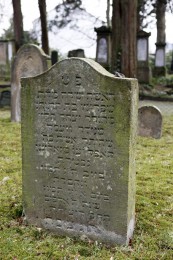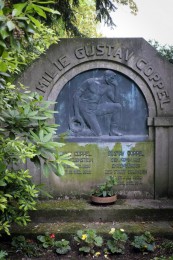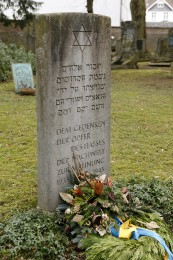
The Jewish burial ground „am Clauberg” was first mentioned in 1718. Its origins remain unclear. The oldest preserved gravestone dates June 15, 1820 and was errected for Sprinz, daughter of Jizchak Halevi, wife of Coppel Samuel.
The burial commission of the community determined in regulations drafted in 1863, that the congregation had to maintain the paths, the surrounding hedge and the iron gateway, that the grave plots had to be allocated sequentially and space-saving, and also the headstones had to be approved by the commission. Usually the cemetery was locked and the chairman had to take care of the key. In 1881 for the first time modern coffins with slanted lids and black painting were admitted, but without any decoration.
Jewish cemeteries are made for eternity, which requires a precise planning to make the most of the limited space. Because of this and also to keep the ideal of equality in death, the community was unwilling to keep free several burial plots for family members. So in 1881 Gustav Coppel was not successfull with his request to reserve future burial plots for his children and children-in-law. Only in 1890 the committee acceded to his request, not least because of his abundant merits for the community. The following year they also decided to accept marital partners from foreign synagogue congregations to be buried in Solingen beside their partners for a fee. In 1914 the board finally approved the Coppel family to establish a family tomb at their own descretion.

According to an allocation plan from 1876 the cemetery commission calculated on 30 years to fill the capacity of the site. They even considered to re-use the oldest burial sites in the end, which was absolutely unusual in Jewish burial culture.
In 1886 the cemetery was edged by a 2.20m high wall and the entrance was relocated from the west to the north side. Meanwhile they calculated on 50 years to fill the site. But already in 1904 the congregation decided to buy a neighboring property. This was probably changed once more with another property in 1913 before they enlarged the cemetery and built a chapel by means of the Gustav-Coppel-foundation established in 1903. The community dedicated a marble commemoration plaque to the charitable couple Gustav and Fanny Coppel.
In 1920 two memorial plaques for the fallen Jewish soldiers of WWI were installed at the synagogue as well as at the cemetery chapel. The plate lists eight names.
During the pogrom night of November 1938 the chapel was damaged and graves were desecrated. In the following night a blasting operation at the chapel failed, whereupon the SA set it on fire. Two victims of the unleashed orgy of violence of November 9 had to be buried the following days: the shot editor Max Leven and the lawyer Willi Hirsch from Opladen who had committed suicide. In August 1939 the municipality demanded from the Jewish community to tear down the rest of the walls of the destroyed chapel.
On April 7, 1941 finally the last burial took place: Lina Mandel née Silberberg was layed to rest beside her husband. Therewith ended 200 years of history of the Jewish cemetery as a „vivid” facility of a vivid community in Solingen.

After the end of war the municipality of Solingen took care of the place. In May 1946 the first recovery measures and horticultural restoration was finished. In 1948 two perpetrators involved in the destruction of the chapel were sentenced to one resp. one and a half years of prison. Since 1951 the cemetery is in possesion of the state association of the Jewish communities of Northrhine. In the 1960s the city re-errected several grave stones and the family tomb of the Coppels was renewed.
In 1987 the municipal Comprehensice school Solingen (meanwhile Alexander-Coppel-Gesamtschule) took over the sponsorship of the cemetery and ever since takes care of the ground and the grave sites. On October 8, 1990 a memorial stone with the following inscription was exposed: „In commemoration of the victims of hate – as a reminder to posterity.”
After Nathanja Hüttenmeister’s „Die Geschichte des jüdischen Friedhofs am Estherweg” in Michael Brocke (Ed.) „Der jüdische Friedhof in Solingen”, Solingen 1996